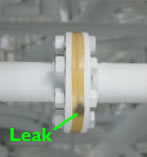
![]()
Detection of explosive conditions in hydrogen applications is important for both safety and economic reasons. One of the enabling technologies for the emerging hydrogen economy is the development of cost-effective hydrogen sensors that possess selectivity and sensitivity, dependability and durability, stability and reproducibility, resistance to chemical degradation and real-time response. An examination of the commercially available point-contact hydrogen sensors indicates the majority of these sensors fall into four main categories: catalytic combustion, electrochemical, semi-conducting oxide sensors and thermal conductivity detectors. If you're interested in learning more about hydrogen safety issues, please view our Hydrogen Basics.
FSEC's research into hydrogen safety and detection techniques has led to the development of a "Smart Paint" and “Smart Tape” described below.
Smart Tape for Visual Hydrogen Leak Detection
 |
| FSEC's "Smart Tape" on pipe flange pinpoints the
location of gas leak from a hydrogen carrying pipeline. (Photo: N. Waters) |
|---|
The concept behind the development of "Smart Paint" is a special formulation that can be painted onto the surfaces to allow detection of minute hydrogen leaks from the hydrogen transporting pipes and devices. Unlike natural gas leaks that can be easily detected by their odor, hydrogen leaks are invisible and odorless. Most applications that utilize hydrogen such as the operations at the NASA-KSC require extremely pure hydrogen with no additives to the gas allowed. FSEC researchers have developed a compound and an application method that permits visual detection of hydrogen presence – allowing operators to precisely pinpoint the location of hydrogen leaks that may occur in the field lines, flanges and joints for hydrogen transport and use. FSEC formulations employ inexpensive metal oxide based powders that can be applied much like paint or deposited onto tapes that adhere to the pipes and flange joints. One version of the formulation is based on white color titania-supported PdO powder that turns black upon contact with hydrogen gas. The color change is very prominent and easily detectable by the naked eye. Another formulation utilizes special materials that change color upon exposure to hydrogen (minute quantities well below the levels that can pose safety risk) reverting to the original color once the hydrogen leak stops (i.e. after the leaky joint has been repaired). The advantage of reversible hydrogen detecting powder is that there is no need for re-application of the sensing material every time a leaky hardware is fixed.
Further development and improvement of the irreversible chemochromic
hydrogen sensing tapes has been carried out at the NASA-KSC. Furthermore,
considerable field testing of the “Smart Tapes” has been
taken place at the Kennedy Space Center and other NASA Centers. So far,
results from these tests have been very positive. A patent application
has been submitted to the U.S. PTO by FSEC researchers on behalf of the
University of Central Florida for aerospace and commercial applications
of these smart hydrogen sensing materials and articles.
